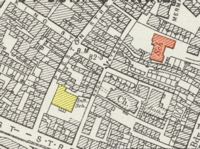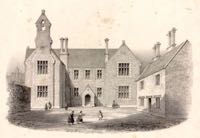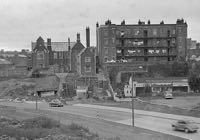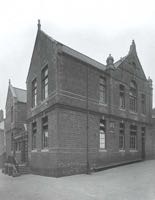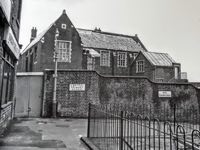
The Central School
Rack Street Naval College
Page updated 7th October 2018
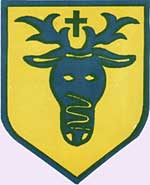 Affectionately, and with a dash of irony, one of the schools that became Central School was known as
the Rack Street Naval College. In 1811, a meeting at the Hotel (Royal Clarence), in that year, of
Nobility, Clergy and Gentry
with the Bishop of Exeter, resolved to establish a central school for
educating children of the poor of every denomination, and for training
school-masters for other parts of the county, based on Dr. Bell's plan.
Affectionately, and with a dash of irony, one of the schools that became Central School was known as
the Rack Street Naval College. In 1811, a meeting at the Hotel (Royal Clarence), in that year, of
Nobility, Clergy and Gentry
with the Bishop of Exeter, resolved to establish a central school for
educating children of the poor of every denomination, and for training
school-masters for other parts of the county, based on Dr. Bell's plan.
In October 1811, a school for 100 boys was opened in Sun Lane, followed the next year by a school for girls. In their haste to open the school, the premises were temporary and in October 1812 a plot of land in Magdalen Street purchased, while £25 shares at 5% interest were offered to assist in funding the new school building. Two schoolrooms for 200 boys and 100 girls were constructed on a site at Magdalen Street, and on 1 August 1814, the Flying Post reported that the premises had been completed, at a total cost of £1,500. The site was on the north side, next to Palmer's Almshouses, on land that would eventually became a new block for the Royal Devon and Exeter Hospital at Southernhay.
By 1817, 914 boys and 597 girls had passed through or were still at the Central School. The Bishop gave 30 of the poorest boys at the school, who had regularly attended church, a pair of shoes and stockings each, in 1825. To raise funds for the school, a sermon was held annually at the Cathedral with a collection at the door; in 1826 £13 18s 5d was raised and it was announced that there were 404 boys and 250 girls attending the school.
By 1850 the school had 230 boys and 160 girls on the roll, supported by annual subscriptions, donations, church collections and a fee of a penny or twopence per child per week, apart from the pupils who were free. Attendance suffered in the early years due to the fee, and other distractions, such as markets, fairs, circuses, executions, military bands and cleaning out the leats would reduce the number of children attending at any one time.
The school had educated 6,912 boys and 5,342 girls by 1855 and Queen's Scholarships were won in the same year by C H Satterley of the boys' school and M A Weeks and S J Martin of the girls' school.
Rack Street Naval College
Space was at a premium and in 1858, while a replacement school was built in Rack Lane at a cost of £2,750, the pupils moved into a building in Preston Street, that had been conveyed to the Dean and Chapter by John Dinham for use as the Rack Street Infants School.
When completed, the new school in Rack Lane was a two storey, T shaped building with girls on the ground floor, and boys on the first. Discipline was strict and in 1864 the Headmaster wrote:
"found five boys on the evening of the 13th in girls' school gave all of them a thrashing"
...and in 1889 a female teacher wrote
"Obliged to interfere on behalf of (the) children after dismissal, as they awaited at the gate by a number of others armed with sticks and, worse still refuse (rubbish) of fish, which is afterwards thrown about the premises. There appears to be no remedy to these annoyances, any protest against them being followed by the grossest of insults to the teachers."
There was an unfortunate death reported at the school in December 1860 when pupils were questioned regarding the death of a boy. The lad, who had been feeling ill, had been knocked backward, falling on his head, by a pupil teacher named Charles Edward Hawker, who was found guilty of manslaughter.
The school log recorded a half holiday, in May 1864, when Garibaldi, the founder of modern Italy, passed through St David's Station, and in August 1866, it was noted that "Many absentees – I fear parents allowed their children to witness the execution of Grant". The headmaster wrote in the log book after the Theatre Royal fire in 1887, "... many of the children are connections of some of those who perished, five children in standard 1 being rendered fatherless and two of the five motherless also."
Children would be expelled from the school for irregular attendance - one such incident saw Henry Gear turned out in 1872. He was then ordered to attend and if he did not by the end of the month a fine of 2s 6d would be imposed. The restrictive curriculum may have added to poor attendance for in 1888 the log book noted "... am teaching some girls in Standard VI to knit gloves, others are knitting petticoats. This is found to be a relief from the monotony of stocking making."
At its peak, the school had over 500 pupils, 300 of whom were boys. In 1902 the school became a Voluntary Aided Church School. It was affectionately known as the Rack Street Naval College by the locals, some say, because many of the boys joined the Navy, and some obtained grants for poor children to attend Dartmouth Naval College. During the early years of the 20th-century, many of the poor children would attend the Coombe Street Mission for their farthing breakfast, before going to Rack Street School. In 1907 His Majesty's Inspectors Reports noted that "Managers and Teachers do all in their power for the benefit, both moral and mental, of the children, who are almost without exception of the poorest class."
In the early 1920s a school camp at Dawlish Warren was introduced, an innovation that was one of the first in the country; the first year the cost was 7s 6d for a week of working and camping, and the next year it became a fortnight at a cost of 15s. In 1938 a reorganisation saw the older pupils transferred to the new Episcopal Senior Schools in the city, and Central School was reorganised into an infant and junior school and the Rack Street Infant School next door closed.
The blitz
All the city schools temporarily closed after the May 1942 blitz. The Central School reopened in the Holloway Street School as the Rack Street premises were used as a morgue and it was not until November 1942 that the ground floor of the old school was reoccupied. After the 1944 Education Act, the school opted for Voluntary Controlled status under the LEA.
On the 6 September 1973, the infants were transferred to a new school on the corner of St Leonards Road and the Topsham Road. Four years later the junior school in Rack Street became a middle school following a reorganization across the city. The old building was starting to show its age, and cracks appeared in a supporting wall. In September 1976 the Middle school pupils moved into new premises adjacent to the Infant school at Parker's Well in St Leonards. The old Rack Street Naval College, the school that educated so many from the West Quarter was demolished and replaced with a block of flats.
Some pupil memories
"...
in the mid-twenties there was a special 'Education Week' in which
all schools in the City took part. I was one of a team of six which
gave a display at the Theatre Royal and the Civic Hall. On the last day
of the week there was a display at the County Ground, which included
Country Dancing and the teams from Central School were placed directly
in front of the Grandstand.
I remember the pageant at St James' Park
about 1922 or 1923. The Highlights of this was the forming of the Union
Jack by the children wearing sashes and head pieces made of red, white
or blue crepe paper... Every class had its own monitors, whose chief
duty was to see that pens and pencils were on each desk and that
inkwells were full." G F Bartlett
"The Warren in those days was almost
bare,
consisting of a rough golf course, a large corrugated hut which opened
during summer months for the sale of sweets, biscuits and mineral
waters from cods bottles. The owners name was Crispen.
... We
slept in
ex-army huts and took our meals (lessons if it was raining) in a
marque. All duties to do such as fetching and carrying water for
washing and cooking, finding firewood for the army field kitchen
boiler, spud bashing, washing up and numerous other jobs..." W
Soper
Sources: Last school magazine July 1976, the Flying Post and Historical Notes on Devon Schools by Robert Bovett.
│ Top of Page │
